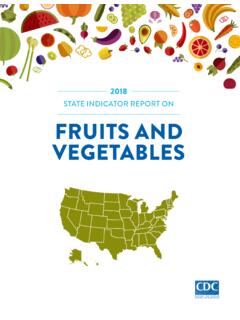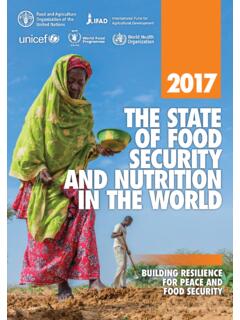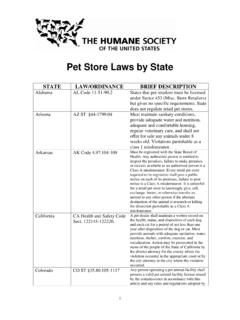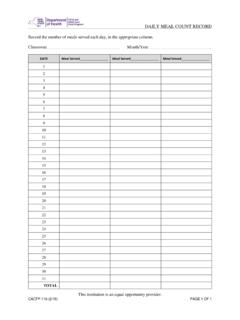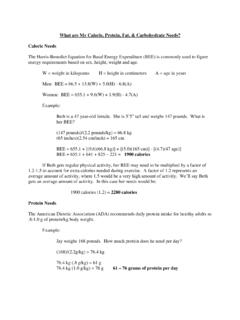Transcription of State of Ohio. Nutrition, Physical Activity, and Obesity ...
1 CS233917-WNational Center for Chronic Disease Prevention and Health Promotion Division of nutrition , Physical Activity and Obesity Overweight and Obesity September 2012 Ohio State nutrition , Physical Activity, and Obesity ProfileObesity has important consequences on our nation s health and economy. It is linked to a number of chronic diseases, including coronary heart disease, stroke, diabetes, and some cancers (NIH Clinical Guidelines, 1998). Among adults, the medical costs associated with Obesity are estimated at 147 billion dollars (Finkelstein, 2009). Many American communities are characterized by unhealthy options when it comes to diet and Physical activity. We need public health approaches that make healthy options available, accessible, and affordable for all - State nutrition , Physical Activity, and Obesity ProfilePage 2 of 4 CDC s Division of nutrition and Physical , and Obesity (DNPAO) supports the nation s capacity to address public health in all policies and establish successful and sustainable interventions to support healthy eating and active living.
2 The Division provides support ( , implementation and evaluation guidance, technical assistance, training, surveillance and applied research, translation and dissemination, and partnership development) to states , communities and national partners to implement policy, system, and environmental strategies. The goal is to improve dietary quality, increase Physical activity and reduce Obesity across multiple settings such as child care facilities, workplaces, hospitals and medical care facilities, schools, and Population of Ohio Estimated Total Population 2010(1) = 11,536,504 Adults age 18 and over(2) = of the total population in 2010 Youth under 18 years of age(1) = of the total population in 2010(1) Census Bureau. State and County QuickFacts. 2011. Available online at (2) Calculated estimated = 100% minus percent of the total population under 18 years old, using State and County QuickFacts, 2010 data from the Overweight and ObesityOverweight and Obesity (3) were overweight, with a Body Mass Index of 25 or greater.
3 Were obese, with a Body Mass Index of 30 or greater. Dietary Behaviors(4) of adults reported having consumed fruits at the recommended level of 2 or more times per day. of adults reported having consumed vegetables at the recommended level of 3 or more times per Activity(5) of adults achieved at least 300 minutes a week of moderate-intensity aerobic Physical activity or 150 minutes a week of vigorous-intensity aerobic activity (or an equivalent combination). of Ohio s adults reported that during the past month, they had not participated in any Physical of Adult Obesity Data:(3) CDC. Behavioral Risk Factor Surveillance System: Prevalence and Trend Data Overweight and Obesity , Obesity Trends, Trends by State 2010. Available online at of Adult Fruit and Vegetable Data: (4) CDC. MMWR September 2010 State Specific Trends in Fruit and Vegetable Consumption Among Adults United states , 2000 2009.
4 Available online at of Adult Physical Activity Data:(5) CDC. BRFSS Behavioral Risk Factor Surveillance System: Prevalence and Trend Data Physical Activity, Physical Activity Trends by State 2009 2010. Available online at Overweight and ObesityOverweight and Obesity (6) were overweight ( 85th and < 95th percentiles for BMI by age and sex, based on reference data) were obese ( 95th percentile BMI by age and sex, based on reference data)Unhealthy Dietary Behaviors(6) Fruit consumption: ate fruits or drank 100% fruit juice less than 2 times per day during the 7 days before the survey (100% fruit juice or fruit). Vegetable consumption: ate vegetables less than 3 times per day during the 7 days before the survey (green salad; potatoes, excluding French fries, fried potatoes, or potato chips; carrots; or other vegetables). Sugar-sweetened beverage consumption: drank a can, bottle, or glass of soda or pop (not including diet soda or diet pop) at least one time per day during the 7 days before the survey.
5 Ohio - State nutrition , Physical Activity, and Obesity ProfilePage 3 of 4 Physical Activity(6) Achieved recommended level of activity: Only were physically active* for a total of at least 60 minutes per day on each of the 7 days prior to the survey. Participated in daily Physical education: of adolescents attended daily Physical education classes in an average week (when they were in school). Physical Inactivity(6) No activity: did not participate in at least 60 minutes of Physical activity on any day during the 7 days prior to the survey. Television viewing time: watched television 3 or more hours per day on an average school day. The 2010 Ohio School Health Profiles assessed the school environment, indicating that among high schools(7) did not sell less nutritious foods and beverages anywhere outside the school food service program. always offered fruits or non-fried vegetables in vending machines and school stores, canteens, or snack bars, and during celebrations whenever foods and beverages were offered.
6 Prohibited all forms of advertising and promotion of candy, fast food restaurants, or soft drinks in all locations. All school-related locations were defined as in school buildings; on school grounds, including on the outside of the school building, on playing fields, or other areas of the campus; on school buses or other vehicles used to transport students; and in school publications. Sources of Adolescent Obesity , Fruit and Vegetable, Sugar-sweetened Beverages, and Physical Activity Data: * Physical activity defined as any kind of Physical activity that increases your heart rate and makes you breathe hard some of the time. (6) CDC, Division of Adolescent and School Health. The 2009 Youth Risk Behavior Survey. Available online at (7) CDC, Division of Adolescent and School Health. The 2010 School Health Profiles. Available online at Overweight and ObesityBreastfeeding(8)Increasing breastfeeding initiation, duration, and exclusivity is a priority strategy in CDC s efforts to decrease the rate of childhood Obesity throughout the United states .
7 Of infants were Ever Breastfed. of infants were Breastfed for at least 6 Mass Index(9)*Among Ohio s children aged 2 years to less than 5 years* were overweight (85th to < 95th percentile BMI-for-Age). were obese ( 95th percentile BMI- for-Age).Sources of Breastfeeding Data:(8) CDC. Division of nutrition , Physical Activity, and Obesity Breastfeeding Report Card 2011. Centers for Disease Control and Prevention National Immunization Survey, Provisional Data, 2008births. Available online at of Child Obesity Data:(9) CDC. Division of nutrition , Physical Activity, and Obesity . 2010 Pediatric nutrition Surveillance System, Table 6 (PedNSS). * BMI data only includes low-income children from the PedNSS sample and do not represent all children.* BMI data is based on 2000 CDC growth chart percentiles for BMI-for-age for children 2 years of age and older. Ohio s Response to ObesityPE in SchoolsThe Ohio Department of Health worked with the Ohio Department of Education to provide SPARK (Sports, Play and Active Recreation for Kids) workshops to Physical education teachers in the highest risk areas of the State to increase the amount of daily Physical activity and improve the quality of Physical education classes offered in schools.
8 Additionally, the Ohio Education Association (ESC) helped to develop model Physical activity policy language, provide regional trainings on policy development, and provide technical assistance on adoption of policies. Ohio - State nutrition , Physical Activity, and Obesity ProfilePage 4 of 4 Physical activity in afterschool programs: CATCH/OAN policy recommendations The Ohio Department of Health worked with Ohio Action for Healthy Kids to recruit and train program personnel at their target goal of 60 afterschool child care programs from high risk areas of the State in the CATCH Kid s Club curriculum. The Ohio Afterschool Network (OAN) completed and presented the afterschool guidelines at 4 afterschool conferences. The guidelines have been printed and are on the following website: The Business Case for Breastfeeding was presented to State agency wellness coordinators and Healthy Ohio Business Council members across the State .
9 Model policies have been developed as a resource, and technical assistance was provided to assist worksites in implementing the directives and laws surrounding breastfeeding friendly worksites. Healthy Meals at WorksitesThe Ohio Department of Health worked with the Ohio State University Extension to provide their Healthy Meals at Worksite program to all State agency wellness coordinators and Healthy Ohio Business Council members across the procurement policies and practices are establishing guidelines for obtaining healthier foods, including fresh fruits/vegetables for worksite cafeterias, vending machines, meetings and conferences. The Snackwise nutrition rating program is provided to all worksites that participate in the training. Technical assistance is provided and model policies are being developed for worksites to Breastfeeding Friendly resource guide and the Healthy Meals at Meetings guide have been posted on the following website: InformationKristen Marschner Scott, MS, RD, LDPublic Health NutritionistOhio Department of Health246 N.
10 High StreetColumbus, OH 43215(614) 466-2248 Linda Scovern, MPH, RD, LD, PAPHSP hysical Activity and nutrition CoordinatorOhio Department of Health246 N. High Street, 8th FloorColumbus, OH 43215(614) 728-2722 (614) 564-2409 RooneyCoordinated School Health ManagerOhio Department of Health246 N. High Street, 8th FloorColumbus, OH 43215(614) 466-1335 ReferencesNIH. Clinical Guidelines Clinical Guidelines on the Identification, Evaluation, and Treatment of Overweight and Obesity in Adults: The Evidence Report. 1998. Available online at , EA, Trogdon, JG, Cohen, JW, and Dietz, W. Annual medical spending attributable to Obesity : Payer- and service-specific estimates. Health Affairs 2009; 28(5): w822-w831.










